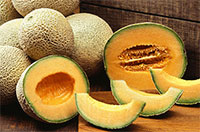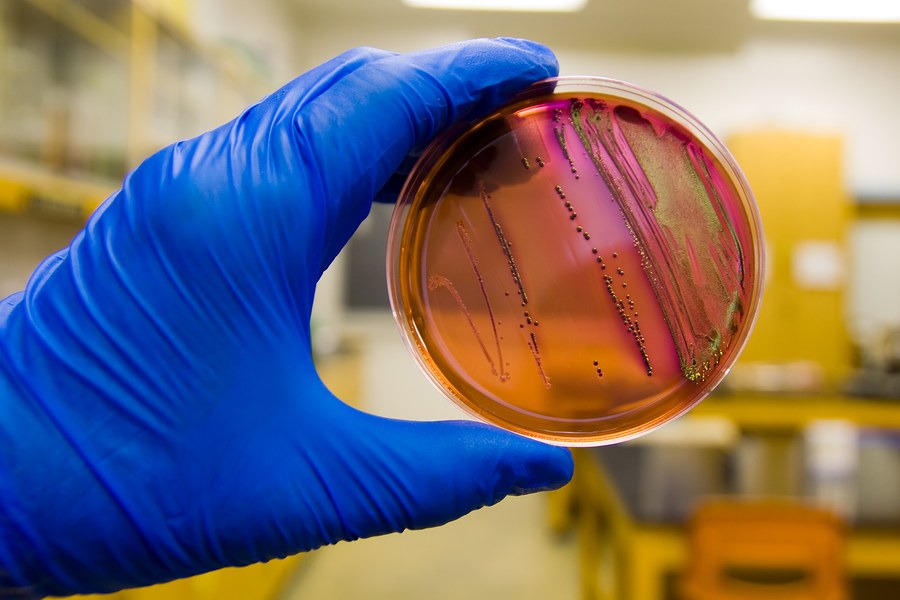Cantaloupes An Outbreak Stuck on Repeat
By: Suzanne Osborne, PhD
On August 22nd 2012, the U.S. Food and Drug Administration (FDA) issued a familiar statement: a cantaloupe recall due to Salmonella contamination. Originating from Chamberlain Farms Produce Inc. of Owensville, Indiana, distribution of the contaminated fruit has led to 204 reported illnesses across 22 states. Two individuals, belonging to a more susceptible demographic, have died. Although tragic in its own right, this information comes as no shock. Salmonella outbreaks associated with cantaloupes have occurred in the United States as recently as 2011 and 2008. On average, more than one outbreak due to cantaloupe contamination has occurred per year between 1984 and 2002. What are the issues inherent in the production of this fruit that can result in this relatively high frequency of contamination?
There are a number of contributing factors that can lead to contamination, such as worker hygiene or sanitation issues with the field, equipment, containers, and transportation vehicles (1). Although Salmonella can survive on the cantaloupe rind for up to 14 days, this external contamination is less problematic. Washing and disinfecting practices on this non-edible portion of the fruit are generally effective at reducing, albeit not eliminating, bacteria from the rind (6, 7). Internalized pathogens, however, localized in the customer-consumed tissue, are of far greater concern as they are protected from external washing procedures. Internalization can occur at damaged sites on the fruit, during washing as water enters the stem scar, or through processing (fresh-cut produce) (6). Recently, internalization of bacteria from contaminated soil and irrigation water has also been considered.
Although cantaloupe roots can uptake bacteria from soil in an experimental setup, the multiple components involved in manure handling and processing makes correlating specific practices with contamination difficult (3, 6). Additionally, bacterial movement from the roots up to the fruit remains controversial (5). Recommendations to separate manure application and harvesting by 60 to 100 days have been suggested, but there is little scientific evidence to support this delay. Soil is also naturally rich in a variety of harmless bacteria. These bacteria in fact appear to protect food crops through natural competition with dangerous bacteria which limits their movement (2, 3).
Attention has now turned to irrigation water as a source of contamination from environmental runoff and wildlife. Water may also facilitate the movement of dangerous pathogens present in soil(4). Interestingly, bacterial numbers found on cantaloupe following contact with contaminated water decreased over time. This is likely due to natural exposure to daytime heat, humidity, and solar ultraviolet light (5). However, it seems that damaged cantaloupes in direct contact with the soil were the most susceptible to internalizing bacteria from contaminated irrigation water (5). More research addressing the microbiological content of agricultural water is needed to help solidify currently paltry regulations regarding this issue (6).
Best practice recommendations concerning agricultural water and soil await further research. Contamination identifiers are often based solely on indicator microbes which, although reflective of good general sanitation practices, may not identify specific pathogens of concern (5). Poorly reported and variable methodologies utilized in research studies also make it difficult to compare and evaluate food sanitation practices (6). More comprehensive soil and water quality diagnostics are needed, concurrent with well-defined soil and water pathogen threshold levels. It is time to give agricultural workers the proactive tools they need to prevent contamination rather than relying on retroactive responses to outbreaks.
REFERENCES
(1) Beuchat, L.R. et al, J. Food Prot. (1995) 59:204-216
(2) Sharma, M. et al, J.Food Prot. (2009) 72:1513-20
(3) Erickson, M.C. et al, Ann. Rev. Food Sci. Technol. (2012) 3:283-310
(4) Mootain, G. J. et al, Food Prot. (2009) 72:2308
(5) Lopez-Velasco, G. et al, Intern. J. Food Microbio. (2012) 158:65-72
(6) U.S. Food and Drug Administration.http://www.fda.gov/Food/ScienceResearch/ResearchAreas/SafePracticesforFoodProcesses/ucm090977.htm
Dr. Suzanne Osborne‘s expertise is in the field of host-pathogen interactions and foodborne bacteria. She obtained her doctoral degree at McMaster University and worked as a Research Fellow at the Hospital for Sick Children (Toronto). She has received numerous awards for her research. Suzanne currently does freelance science writing and grant writing.
.
To have more articles like this emailed to your inbox, become a GFSR Member today!

-
 FeaturedRisk management
The Cost of a Breach: What a Cyberattack Could Mean for Food Safety Recalls
FeaturedRisk management
The Cost of a Breach: What a Cyberattack Could Mean for Food Safety Recalls
-
 FeaturedRisk management
Securing the Food Chain: How ISO/IEC 27001 Strengthens Cybersecurity
FeaturedRisk management
Securing the Food Chain: How ISO/IEC 27001 Strengthens Cybersecurity
-
 FeaturedRisk management
Revolutionizing Food Safety Training: Breaking Out of the “Check-the-Box” Mentality
FeaturedRisk management
Revolutionizing Food Safety Training: Breaking Out of the “Check-the-Box” Mentality
-
 GFSI Standards
GFSI 2025: Building Trust, Tech-Forward Solutions, and Global Unity in Food Safety
GFSI Standards
GFSI 2025: Building Trust, Tech-Forward Solutions, and Global Unity in Food Safety
-
 FeaturedFood Safety
Integrated Pest Management: Strategies to Protect Your Brand’s Reputation
FeaturedFood Safety
Integrated Pest Management: Strategies to Protect Your Brand’s Reputation
-
 FeaturedFood Safety Culture & Training
No Open Door Policy: Challenges That Impact Pest Control in Food Processing Plants
FeaturedFood Safety Culture & Training
No Open Door Policy: Challenges That Impact Pest Control in Food Processing Plants




